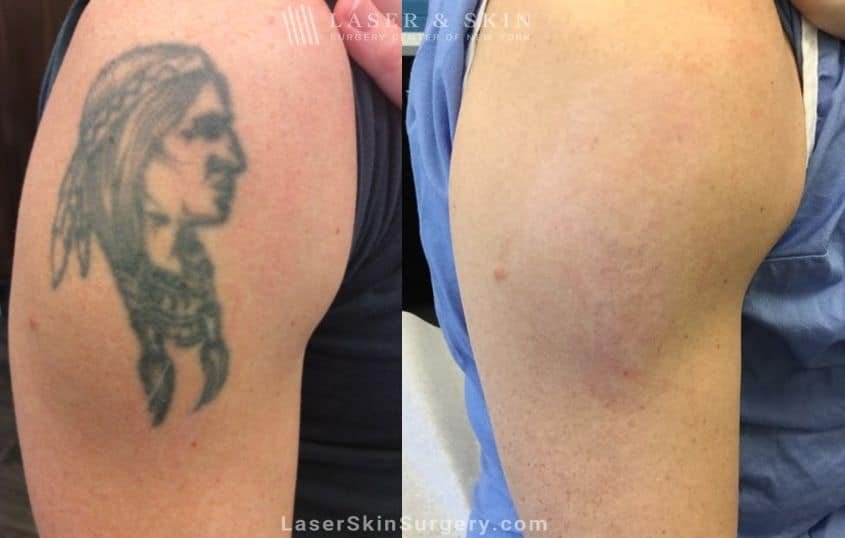Tattooing over a previously removed tattoo is absolutely possible, but requires your skin to be fully healed and the old design faded significantly or completely gone. After multiple laser removal treatments to effectively fade and remove tattoos, your skin specialist will advise allowing ample time to heal – typically 6-12 weeks as a general guideline. I’ve seen countless clients rush this crucial healing process, only to develop sensitivity, redness, and signs of irritation that could have been avoided. The removal process needs patience until the area is completely closed before attempting a new tattoo’s ink, which then takes well without complications.
For optimal results, consult with both a qualified laser technician for the appropriate number of sessions your specific tattoo requires (depending on color, size, and depth), and an experienced tattoo artist specializing in cover-ups. The new tattoo design must be carefully chosen to accommodate any fading of the original tattoo. Through proper planning and consultation with professionals, even difficult cover-ups are achievable. From my fifteen years in the studio, I’ve found that when clients prioritize skin health and work with an experienced tattoo artist, we can create an adjusted, suitable design that will effectively cover any remaining ink from the old tattoo, addressing any scarring from the laser removal process to affect the final appearance of your cover-up tattoos in the most positive way, leading to your desired outcome.
Can You Tattoo Over a Removed Tattoo?
If you’re looking to get rid of an unwanted tattoo, you might be wondering whether you can simply cover it with a new design. Unfortunately, it’s not that simple. Laser removal works by breaking down ink particles under the skin, leaving behind faded but still big remnants that make another tattoo difficult to go over cleanly. I’ve seen clients try to skip the full process, only to end up with blurry, uneven results.
The best option is to go through the complete removal first. Once your skin is free of the old ink, you’ll have a blank spot ready for fresh tattoos—or you can leave it bare as a reminder of a lesson learned. Some people choose to leave it as part of their body’s story, while others prefer a fresh start. Either way, patience is key.
Pros of Tattooing Over a Removed Tattoo
Getting a new tattoo over a removed one actually has several advantages that might surprise you. First, a fresh design can beautifully camouflage any scarring or discoloration left behind from the removal process – I’ve seen skilled artists work magic on clients who thought their skin would never look even again. Second, it gives you the perfect opportunity to change your mind about that particular artwork you’re no longer sure about – you’re not stuck with old regrets when you can replace them with something meaningful. The third and most practical benefit? It helps disguise any remaining unevenness in your skin tone that resulted from laser treatments. Just remember – making this decision should always involve a consult with your professional tattooed, as they’ll know exactly how to work with your unique canvas.
Cons of Tattooing Over a Removed Tattoo
One major con of tattooing over removed ink is how surprisingly difficult it can be to find an artist who’s both willing and comfortable working on scar tissue – many lack the specific experience and expertise needed to adequately cover up these tricky areas. Additionally, the removal process itself often damages the skin, making it harder for new ink to take hold properly, and there’s always a possibility your fresh tattoo won’t look as good as your old one did. After seeing many clients struggle with this, I always advise thinking twice before getting a covering tattoo – what seems like a simple fix often requires more consideration than people realize.
What is Laser Tattoo Removal?
Laser tattoo removal is a non-invasive process that works by using concentrated light beams to safely remove unwanted ink. The device emits a high-intensity beam that passes through your skin’s surface to target the ink particles beneath. What’s remarkable is how it breaks apart these pigments into tiny fragments without harming the surrounding tissue – I’ve seen firsthand how this precision makes modern removal so much safer than older methods.
The science behind it is fascinating. When the laser’s heat energy hits your tattoo, it shatters the ink into pieces small enough for your white blood cells to carry away. Your immune system then naturally expels these foreign particles over time through your lymphatic system. This is why you’ll need multiple sessions – typically between 6-8 weeks apart – to completely remove a tattoo. The number of treatments varies based on factors like ink color, density, and even the type of pigment used by your original artist.
For those considering a redo, this gradual process actually creates the best possible canvas for your new design. As an ink fades over several continued treatments, it gives artists more opportunity to create something fresh. Picoway technology, currently the most advanced treatment available, can even remove tattoos in half the time compared to traditional lasers, making it a great option for impatient clients.
However, proper healing time is crucial. Even after your final session, I always recommend waiting at least 8 weeks before re-tattooing the area. Your skin needs time to fully restore itself – rushing this process can impact the final results. The length of your recovery will vary, and often it’s best to wait longer to ensure complete restoration of your previously tattooed skin.
How Long After Tattoo Removal Can You Get a Cover-Up?
In most cases, you’ll typically need 3-5 laser sessions to properly fade your old tattoo enough for a cover-up. But here’s what many don’t realize – just because the ink is lighter doesn’t mean you’re ready. I always recommend working closely with your reputable tattoo artist throughout the fading process to make sure it’s light enough for their needs. The right artist will tell you exactly when your skin reaches the ideal blank canvas state to achieve their envisioned artwork – rushing this can compromise the final results.
What are the risks?
The main complications with re-tattooing over previously tattooed skin involve scar tissue – while scarring from laser removal is uncommon, it can occur as a rare side effect. When present, this tissue may obstruct new ink from settling regularly, potentially distorting your design’s definition. That’s why I always insist clients have their specialist declare any scar tissue before undergoing treatment – they’ll assess your skin’s suitability and outline a personalized care plan with expert pre and post-treatment advice to minimize impact on your final results.
For the best outcome, follow all aftercare guidelines religiously. The form of treatment matters too – certain methods leave less prevalence of scarring, giving your artist a better canvas to work with. Don’t skip the consultation where they’ll declare any potential issues that might affect your new tattoo’s appearance.
Can you get a tattoo after laser hair removal?
The short answer is yes – not only can you get a tattoo after laser hair removal, but the procedure might actually enhance your final outcome. Here’s why: both treatments use similar practices involving light and heat energy to target pigment in the skin, though they differ in what they’re targeting – hair follicles versus ink. The laser works by disrupts the hair’s growing environment during its most receptive active growth stage, which requires multiple sessions to ensure complete removal.
What many don’t realize is that properly completed laser hair removal leaves your skin smooth and long lastingly free from hair, creating an ideal canvas. The required sessions vary per person, but once finished, you only need to wait about 6 weeks before getting inked. I’ve seen firsthand how this treatment leads to better ink pigment retention since there’s no hair to present interference. Just remember – while the practices are similar, they work differently, so always consult your artist about timing.
Can you get a tattoo after laser removal?
In most cases, the answer is yes – you absolutely can get a new tattoo over a removed one. But here’s what most people don’t realize: there’s a crucial waiting time that must be endured. Just like when getting a fresh tattoo, your skin needs adequate time to heal after laser removal. This process isn’t just recommended – it’s necessary for proper results. I’ve seen too many clients rush this stage only to end up with compromised artwork.
The undergoing of removal treatments creates trauma to the skin that requires full recovery before new ink can be applied properly. While it’s tempting to cover up old tattoos immediately, patience during this healing phase makes all the difference in how your new design will look and last.
Getting a new tattoo after having one removed: what you need to know
Contrary to what many traditionally thought, tattoos aren’t necessarily permanent anymore thanks to modern laser removal advancements. With today’s high success rates for complete tattoo removal, the idea of getting re-tattooed over previously tattooed skin becomes incredibly tempting. I’ve worked with countless clients who were amazed at how effectively we could remove old designs to make room for fresh ink.
However, there are key things you need to know before committing to a new tattoo post-removal. The skin undergoes significant changes during the removal process, and understanding these changes is crucial for optimal results. Not all ink lifts equally, and your artist will need to assess how well your canvas has healed before creating new artwork.
FAQS
Can I get a tattoo over a tattoo removal?
The answer is yes, you can get a new tattoo over a removed one, but there’s a crucial waiting period you must respect. After completing your laser removal treatment, your skin needs at least 6-8 weeks (often longer) to fully heal and restore itself. I always tell my clients to wait until their skin is completely healed, free from any signs of scarring or irritation before getting new ink. Scar tissue from the removal process can affect how the ink settles, potentially altering the overall appearance of your desired design.
That’s why it’s so important to consult with both a removal specialist and your tattoo artist. The specialist will ensure your skin is healthy enough, while the artist can discuss the best approach for covering the area and achieving your vision. Thanks to advancements in technology, modern laser treatments can remove tattoos with minimal scarring, greatly improving your chances of a successful cover-up. But remember – patience during this process is key to getting the best possible outcome.
How long after tattoo removal can I tattoo over?
The recommended healing time before getting a new tattoo after laser removal treatment is typically 6-12 weeks, though in certain cases this process may take longer – I always advise clients to have their skin checked by a professional first, as only they can confirm when you’re truly ready to confidently book that first session with your artist.
Can you put a new tattoo over an old one?
The simple answer is yes – you can absolutely get a new tattoo over an existing one, which is commonly called a cover-up. However, these require special skill to execute properly, as the artist needs to work with what’s already there while completely transforming the look.







